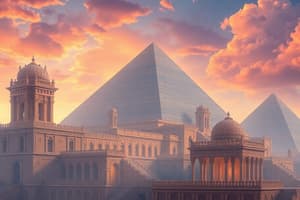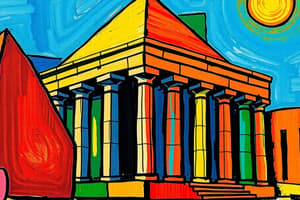Podcast
Questions and Answers
What was the primary function of Egyptian temples, according to the text?
What was the primary function of Egyptian temples, according to the text?
- Public meeting places for citizens
- Residences for the pharaoh and his family
- Homes for gods and goddesses (correct)
- Fortifications for protection against invaders
Which individuals were typically allowed access to the shrine within an Egyptian temple?
Which individuals were typically allowed access to the shrine within an Egyptian temple?
- Only the pharaoh and most important priests (correct)
- All citizens of Egypt
- The architects of the temple
- All priests of the temple
What was the purpose of the processions conducted in Egyptian temples?
What was the purpose of the processions conducted in Egyptian temples?
- To move building materials.
- To carry the statue of god or goddess. (correct)
- To display the wealth of the pharaoh.
- To welcome dignitaries into the temple.
What material were Egyptian temples primarily built with?
What material were Egyptian temples primarily built with?
What was represented by the Pylon or Entrance Wall of the temple, according to the text?
What was represented by the Pylon or Entrance Wall of the temple, according to the text?
Flashcards
Avenue of Sphinxes
Avenue of Sphinxes
A path leading to the temple entrance, featuring sphinx statues.
Shrine
Shrine
A sacred area in the temple housing the statue of a god or goddess.
Offerings
Offerings
Gifts made to gods or goddesses, particularly on feast days.
Pylon
Pylon
Signup and view all the flashcards
Reliefs and Paintings
Reliefs and Paintings
Signup and view all the flashcards
Study Notes
Egyptian Temples
- Egyptian temples were considered homes for gods and goddesses
- Constructed of durable stone
- Temples were large and complex
- Temples had different sections
- Access to the temple was through an avenue of sphinxes
- Monumental gate led to multiple connected rooms
- Most important priests and the pharaoh could enter the shrine
- Shrine held the god's or goddess's statue
- Feasts were celebrated with processions of the god's or goddess' statue
- Walls and ceilings of temples had reliefs and paintings
- Reliefs and paintings are historical records
Temple Structure
- Temples had an entrance called a pylon, with obelisks at the front
- Obelisks were tall, narrow monuments, representing a path between Earth and sky
- Temples were supported by huge columns
- Covered rooms were accessible to priests
- A shrine room housed statues of gods and goddesses
Studying That Suits You
Use AI to generate personalized quizzes and flashcards to suit your learning preferences.




